![]()
![]()
![]()
Use LEFT and RIGHT arrow keys to navigate between flashcards;
Use UP and DOWN arrow keys to flip the card;
H to show hint;
A reads text to speech;
24 Cards in this Set
- Front
- Back
|
Half a billion years of backbones |
In Cambrian period, 530 million years ago, an astonishing variety of invertebrate animals inhabited the earth One type of animal gave rise to vertebrates, one of the most successful groups of animals Myllokunmingia fengjiaoa was one of the first. |
|
|
One lineage of vertebrate |
Colonized land 365 million years ago Gave rise to amphibian, reptiles, and mammals There are more than 57000 species of vertebrates including largest organisms ever to live |
|
|
Chordates |
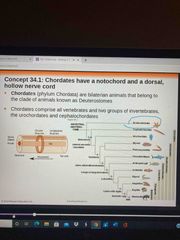
Bilaterian animals that belong to the clade of animals known as Deuterostomes Comprise of all vertebrates and 2 groups of invertebrates, the urochordates, and cephalochordates |
|
|
Derived characters of Chordates |
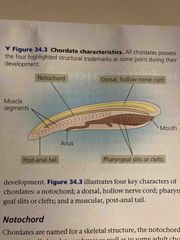
Some species have some of these traits only during embryonic development Notochord Dorsal, hollow nerve cord Pharyngeal slits of clefts Muscular post and tail |
|
|
Notochord |
Longitudinal flexible rod Btw digestive tube and nerve cord Provides skeletal support throughout most of the length of a chordate In most vertebrates, a more complex jointed skeleton develops and adult retains only remnants of the embryonic notochord ie: in humans: reduced and forms gelatinous disks btw the vertebrate |
|
|
Dorsal hollow nerve cord |
The nerve cord of a chordate embryo develops from a plate of ectoderm that rolls into a tube dorsal to the notochord The nerve cord develops into the central nervous system: brain and spinal cord |
|
|
Pharyngeal slits or clefts |

In most chordates, grooves In pharynx that develop into slits that open outside the body |
|
|
Functions of pharyngeal slits |
Suspension-feeding structures in many invertebrate chordates (think of gwhales that filter water out) Gas-exchange in vertebrates (except vertebrates with limbs) Develop into parts of the ear, head, and neck in tetrapods |
|
|
Muscular,post-anal tail |

Chordates have a tail posterior to the anis Tail is greatly reduced in embryonic development Contains skeletal elements and muscles Provides propelling force for aquatic man species |
|
|
Derived characteristics of vertebrates |

1. 2 or more sets of Hox genes (lancelets and tunicates have one) 2. Vertebrate that encloses spinal cord takes over mechanical roles of notochord; elaborate skull 3. Neural crest: cells along edges of the closing of the neural tube of an embryo |
|
|
Origins of bones |
Mineralization originated with mouth parts Vertebrates endoskeleton became fully mineralized later |
|
|
Lobe Fins |
Originated in the Silurian period Have muscular pelvic and pectoral fins they use to swim and walk underwater |
|
|
Early vertebrate evolution |
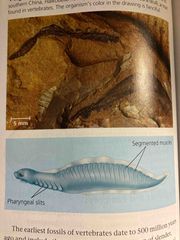
Fossils from Cambrian explosion document Most primitive fossils are Haikouella Had brain, eyes, muscle segments Lacked jaw, skull and ears |
|
|
Origins of bones and teeth and lobe fins |
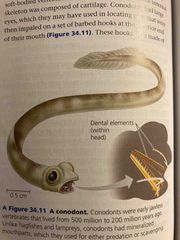
Conodonts we’re earliest in 500 million years ago Had barbed hooks at anterior end of mouth to capture prey These hooks and another set of dental elements in the pharynx were mineralized |
|
|
Another jawless vertebrates |
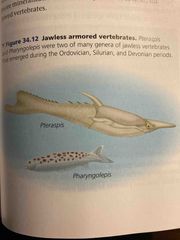
Had muscle fit sucking Armored with plates of mineralized bone Extinct at end of Devonian era |
|
|
More mineralized bone development |
The vertebrate skeleton evolved as a structure made of unmineralized cartilage Mineralized bone first appeared on the outer surface of skull 470 million years ago Skeletons with a thin layer of bone lining the cartilage appeared 430 million years ago |
|
|
A |
A |
|
|
Lancets |
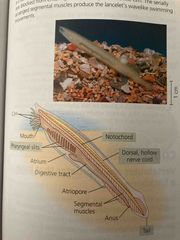
Basal group of living chordates (earliest divergence) |
|
|
Tunicates |
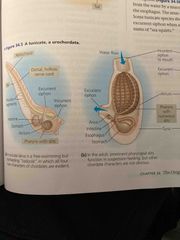
Urochordata More closely related to other chordates than the lancelets (cephalochordata) |
|
|
Early chordate evolution |

Lancelets had a swollen top at anterior end of dorsal nerve cord which has the same Hox genes that create a brain. In tunicates, have genes associated with heart, thyroid glands and embryonic cells |
|
|
Hagfish and lamphreys |
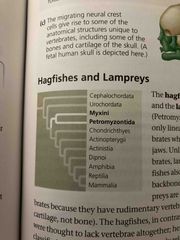
Myxini and petromyzonida Only who lack jaws and do not have backbone (have cartilage instead) Form the clade of living jawless vertebrates called cyclostomes |
|
|
Early vertebrate evolution |
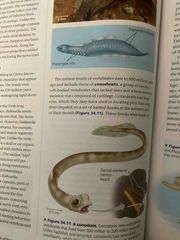
Haikouella: small brain and eyes but no ears or skull Myllokunmingia: early signs of skull, ears and eyes. First chordate to have a head. Enabled coordination and feeding (lacked vertebrate) Conodonts: no jaws, but hooks made of mineralized dental tissue |
|
|
Early vertebrate evolution continued |

Vertebrates with additional innovations emerged. Had paired fins, inner ear for balance, lacked jaws but had muscular pharnyx for sucking Armored with mineralized bone |
|
|
Done part 1 |
A |

